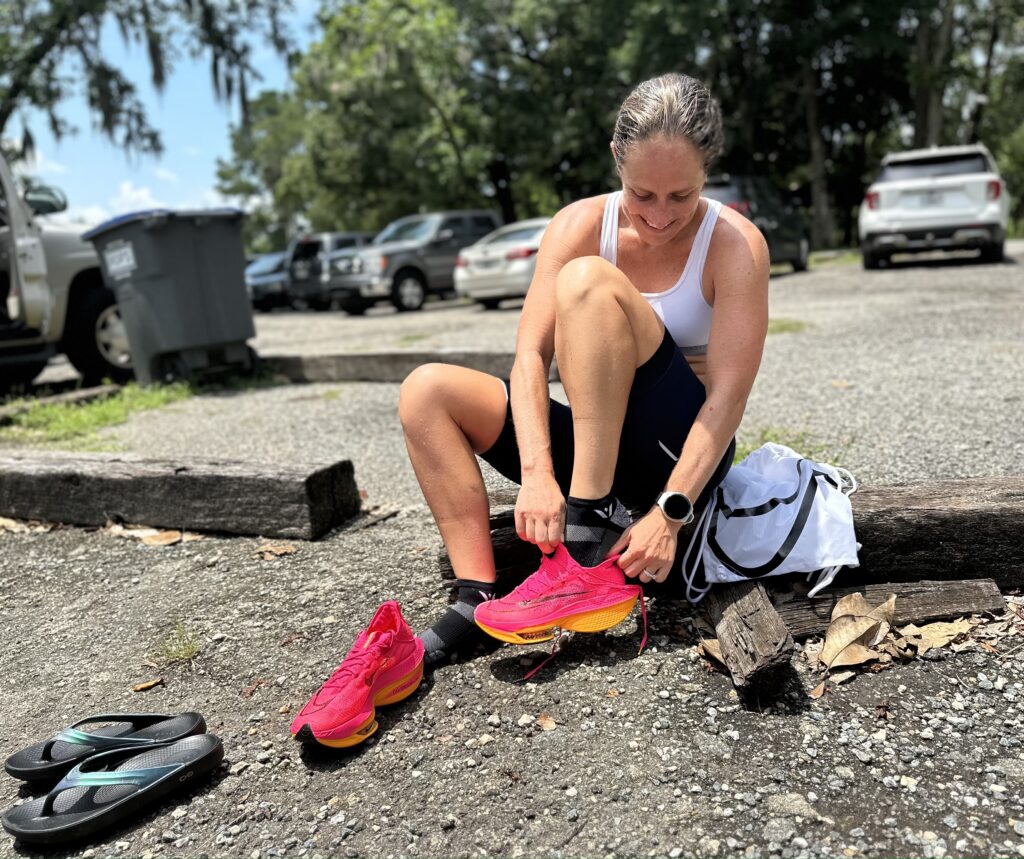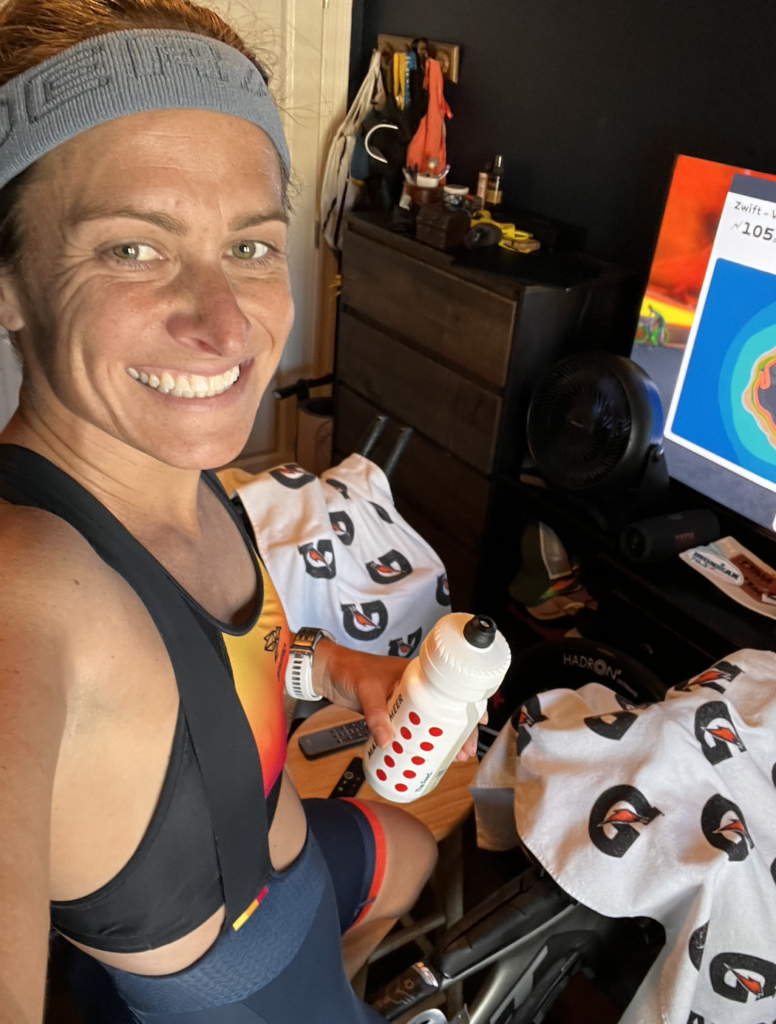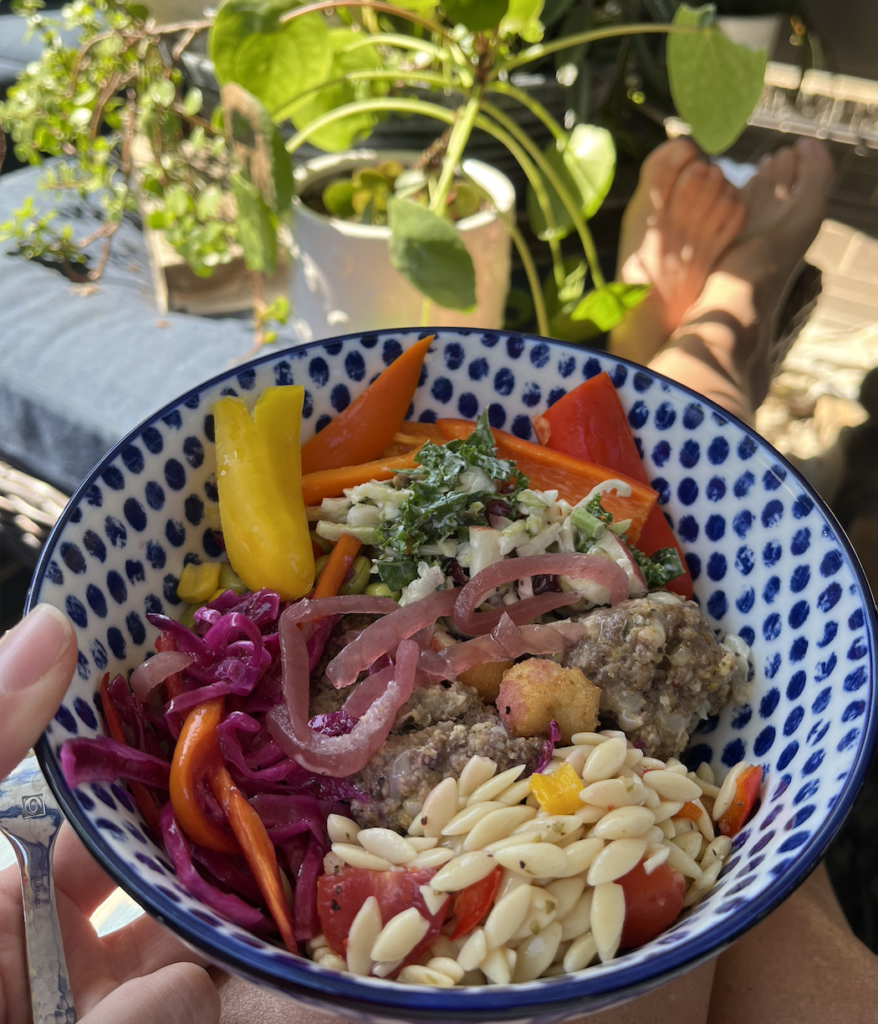
Do you struggle to find time to fit triathlon training in your busy life? You’re not alone. Balancing work, family, school, and other commitments can be overwhelming.
But by becoming an expert in time management, prepping ahead of time, keeping a schedule, being flexible, and having a great support system, you can fit triathlon training into the chaos of every day life.

Prep as much as you can pre-workout
Efficiency is the name of the game when it comes to fitting triathlon training into a busy lifestyle. I only have so much time I can devote to training each day, so that means I need to prep as much as I can before each workout.
For example, today I had a 45 minute run followed by a 45 minute bike ride. That’s a lot to get done in the morning before work, so I had to plan ahead. We made our bottles the night before and put them in the fridge, so our hydration was ready. I set out my clothing and had a towel, heart rate strap, and bike shoes sitting next to my bike. It pays to be organized; try to keep all of your gear in one place so you don’t have to hunt for things in the morning while you’re still half asleep.
Multi-tasking is your friend. I like to stretch before I workout, so I ate a snack and had a drink while I was foam rolling. After the workout, I was going to want a protein shake, so I had the mix already in my shaker bottle. When I finished my workout, I dropped my sweaty clothes in the laundry, filled the bottle up with water, and drank it while I was taking a shower. (This is my favorite shaker bottle and protein mix I LOVE- First Endurance Ultragen.)

Having a schedule is key
This is where having a coach helps tremendously. I don’t have time to figure out what workout to do each day. Instead, I look in my Training Peaks app the night before and can see exactly what my coach has planned for the next workout. This is helpful so I can prep things ahead of time and also so I know how early I have to set my alarm. It’s also great because she knows what type of workout, and how many workouts, I need to do in order to improve performance, but also how to balance that with recovery time so I don’t get injured.
If you don’t have a coach, setting up a simple training schedule can help. When I first started triathlon, this is the example I followed, and we use the same basic framework today. (When I first started triathlon, I got this book- Joe Friel- Triathlete’s Training Bible, and it’s full of great info.)
- Monday- Off day or swim
- Tuesday- Bike/Run
- Wednesday- Swim/Gym Strength
- Thursday- Bike/Run
- Friday- Swim/Gym Strength
- Saturday- Long Bike
- Sunday- Long Run
As a triathlete, you will need to practice all three disciplines multiple times during the week. That means some days will have double workouts. It sounds intimidating, but there’s a trick for this too.
A bike workout followed by a quick run is called a “brick,” and it’s a great way to get in both a cycling and run session in a short period of time. Also, it’s important to learn how it feels to run off the bike, because your legs might be tired and sluggish. But that’s what you have to do during a triathlon, so it’s good to practice!
Strength work is important to both improve performance and prevent injury, but it can be hard to fit another workout into to a busy schedule. If you have a gym with a pool, that makes it easy! Do strength as a warm up, get all sweaty, and then hop in the pool afterwards to swim.
We rarely have time to make it to the gym, so we often do strength in our living room. You only need a few pieces of equipment: kettlebell, a few weights, and a stretch band to get a good workout. We set up a circuit in our living room, crank up the music, and workout while we’re waiting for dinner to cook. (a 20 lb. kettlebell like this is great. Also, there’s a really cool Kettle Gryp that you can use to convert your hand weights into a kettlebell.)

Meal prep is your friend
Speaking of cooking dinner, you mean we have to do all of this training and feed ourselves too?! Yeah, and hopefully it’s something relatively healthy. Here’s a tip. We’ve made this one change to our routine in 2024, and it’s helped us save both time and money… Meal-prep!
On Sunday, we cook a bunch of protein on the grill, whether it’s chicken, pork, or sausage. Then, we use an Instant Pot to make a few pounds of brown rice in literally 20 minutes. Finally, we microwave steamer bags of vegetables, like peas or green beans. We portion it into containers and Voila! Lunches for the whole week. (These glass meal-prep containers are awesome.)
Also, we’ve been making overnight oats in individual Mason jars. In the morning, you just grab one, pop it in the microwave, and go. It takes some prep work, but that means all we have to do is plan dinners during the work week. Also, we’re saving a lot of money by not eating out for lunch, and it’s a healthier option. Win-win.
Get enough sleep
This one can be challenging. One one hand, we need enough sleep in order to recover properly from triathlon training, but many of us have to fit workouts in the early morning or at night, so we often have to sacrifice sleep. It’s a double-edged sword. The only tip I have for this is to have good sleep hygiene to maximize what sleep you can get. For Matt and I, that means not looking at any screens 30 minutes before bed and only using the bedroom for sleep, not watching TV or even reading. You want to get your body into a routine so that when your head hits the pillow, your body knows it’s time to sleep.
Be flexible and adjust when needed
We’ve never had a training cycle that went 100% to plan. Things happen, whether it’s a sick kid, a work trip, an injury, family obligations, ect. Being able to adjust your schedule and adapt isn’t always easy, but it’s an important skill to learn. Chances are, at some point during a race, something won’t go to plan. Your ability to be flexible and make good decisions on the fly is what will ultimately determine your success.
For example, this past Sunday, we wanted to go to church, but I also had a long run, and we needed to meal prep and clean the house. We packed our run gear, went to the early service, and did our long run on the nearby trails. That meant changing in the car in the parking lot, but sometimes you’ve got to do what you’ve got to do to get it all done. More importantly, switching up our normal routine was a lot of fun!

Have a support system
I’ve used the words “our” and “we” a lot in this post, and that’s because my husband, Matt, is a triathlete as well. That does make it a lot easier, because we’re often doing similar workouts at the same time. But even if your partner isn’t a triathlete, this is something you can get via a friend, local triathlon club, coaching group, or online community. Having accountability is motivating and helps keep you on track.
If you’ve seen the movie, “Kung Fu Panda,” there’s a scene I like when Po asks Master Oogway to tell him the secret to life.
Master Oogway replies, “The secret to life is… nothing. There is no secret ingredient. It’s just you.”
There is no secret ingredient to fitting triathlon training into a busy life. But you can do it.
It’s not always easy, but it’s definitely possible. Prioritize what’s most important to you, organize, plan ahead, be flexible, and surround yourself with supportive people, and you will be well on your way.


